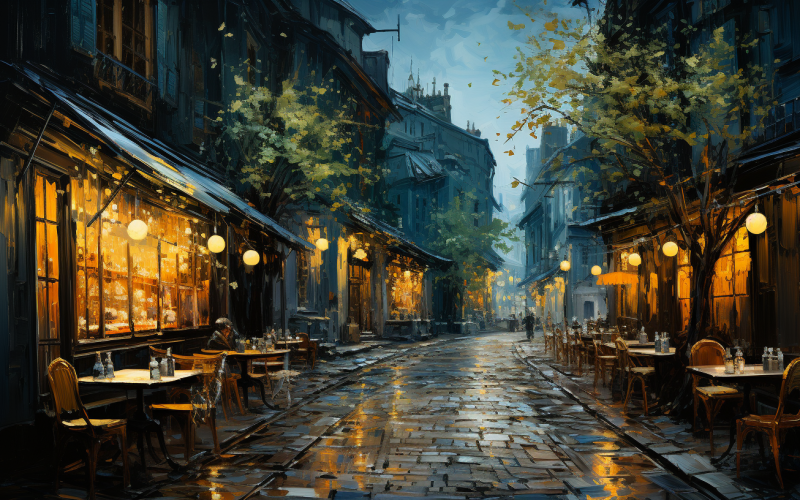Vincent Van Gogh, one of the most renowned figures in art history, created numerous masterpieces that have captivated audiences worldwide. Among his celebrated works is “Cafe Terrace on the Place du Forum,” painted in September 1888.
This artwork stands out not only for its vibrant colors and dynamic composition but also for the glimpse it offers into Van Gogh’s meticulous artistic process.
Understanding how Van Gogh might have approached this painting, from initial sketching to the final brushstrokes, provides deeper insight into his creative genius.
Inspiration and Initial Sketches

Van Gogh’s inspiration for “Cafe Terrace on the Place du Forum” came from his surroundings in Arles, France. Fascinated by the lively atmosphere of the local cafes, he sought to capture the nocturnal vibrancy and the interplay of artificial light against the dark sky. Van Gogh was known for his habit of creating quick sketches to capture his immediate impressions.
For this painting, he likely began with pencil or ink sketches, mapping out the composition and noting key elements like the positioning of the cafe, the arrangement of tables and chairs, and the spatial relationship between the buildings and the starry night sky.
Composition and Perspective
One of the striking features of Vincent Van Gogh “Cafe Terrace on the Place du Forum” is its use of perspective. Van Gogh employed a technique that draws the viewer’s eye into the depth of the scene, leading from the foreground tables to the buildings in the background and the starry sky above.
He might have used a grid system in his sketches to ensure accurate perspective, a common technique among artists to maintain proportionality and spatial coherence. This method would help him visualize the final composition and make adjustments before starting on the canvas.
Color Palette and Underpainting

Color played a crucial role in Van Gogh’s artistic process, and “Cafe Terrace on the Place du Forum” is a testament to his bold use of color. He often used complementary colors to create vibrant contrasts. In this painting, the warm yellows of the cafe’s lights are set against the cool blues and purples of the night sky and shadows.
Van Gogh likely started with an underpainting, a monochromatic version of the final piece, which helped him define the tonal values and lay the groundwork for the layers of color to follow. This step ensured that the final painting had a cohesive structure and balanced composition.
Layering and Brushwork
Van Gogh’s brushwork is distinctive and adds a dynamic texture to his paintings. In Vincent Van Gogh “Cafe Terrace on the Place du Forum,” his strokes vary from short, rhythmic dabs to longer, sweeping lines, creating a sense of movement and life. He used thick applications of paint, a technique known as impasto, which added dimensionality to the work.
Van Gogh likely built up the layers gradually, starting with broader areas of color and refining details with subsequent layers. This method allowed him to adjust the interplay of light and shadow and enhance the painting’s overall vibrancy.
Attention to Detail
Despite his often rapid painting style, Van Gogh paid meticulous attention to detail. In “Cafe Terrace on the Place du Forum,” he carefully rendered the textures of the cafe, the cobblestone street, and the distant buildings.
The play of light on different surfaces—wood, stone, fabric—was achieved through deliberate, varied brushstrokes. He also captured the subtle nuances of the night sky, infusing it with a sense of depth and brilliance through tiny, star-like dots and swirling patterns.
Emotional and Symbolic Elements

Vincent Van Gogh “Cafe Terrace on the Place du Forum” is not just a depiction of a scene but also a reflection of Van Gogh’s emotional state and symbolic vision.
The warm, inviting glow of the cafe contrasts with the cool, serene night, possibly symbolizing the comfort of human connection amidst the vast, sometimes isolating universe.
Van Gogh’s use of vibrant colors and dynamic composition conveys his emotional intensity and unique perception of the world around him.
Final Touches and Finishing
The final touches in Van Gogh’s paintings were often about refining the overall harmony and ensuring that each element contributed to the intended emotional impact. For “Cafe Terrace on the Place du Forum,” this might have involved subtle adjustments to color intensity, enhancing certain details, and ensuring that the composition’s balance was perfect.
Van Gogh’s attention to the interplay of light and shadow in these final stages would ensure the painting’s luminous quality and dynamic presence.
Legacy and Impact
The artistic process behind Vincent Van Gogh “Cafe Terrace on the Place du Forum” reveals much about his innovative techniques and his ability to transform ordinary scenes into extraordinary visions. This painting not only showcases his technical prowess but also his emotional depth and unique perspective. Today, it continues to inspire and captivate, offering a window into Van Gogh’s creative mind and the world as he saw it.
Van Gogh’s meticulous process, from sketching to final brushstrokes, underscores his dedication and artistic brilliance. “Cafe Terrace on the Place du Forum” remains a timeless piece, celebrated for its vibrant color palette, dynamic composition, and profound emotional resonance. Understanding the intricacies of its creation enriches our appreciation of Van Gogh’s unparalleled contribution to the world of art.











